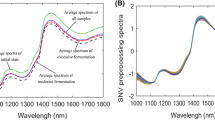Abstract
Multivariable models based on chemometric analyses of the tea infusion sensory data and FT-NIR spectra of 70 “Biluochun” green tea (Camellia sinensis L.) samples were generated aiming to predict the scores of sensory attributes of green tea. Modified BP_AdaBoost algorithm was used to develop the models. The synergy interval partial least square (siPLS) algorithm was applied to select the wavenumbers for the prediction model of sensory properties in order to take only significant spectral intervals into account. Some parameters were optimized by cross-validation in model calibrations. Experimental results showed that the optimal BP_AdaBoost model was achieved with four principal components (PCs), when 184 variables in the combination of four spectral intervals [3 17 19 21] were selected by siPLS. The predicted precision of the best model obtained were as follows: the root mean square error of cross-validation (RMSECV) was 5.0305 and the correlation coefficient (R c) was 0.8554 in the calibration set; the root mean square error of prediction (RMSEP) was 6.0807, the correlation coefficient (R p) was 0.7717, and the ratio performance deviation (RPD) was 1.59 in the prediction set. Finally, the BP_AdaBoost model revealed its superior performance when compared with back propagation neural network (BPNN) model. The overall results demonstrate that FT-NIR spectroscopy technique can be successfully used in the evaluation of sensory quality of green tea, and BP_AdaBoost algorithm shows its superiority in model calibration.



Similar content being viewed by others
References
Ali HRH, Edwards HGM, Scowen IJ (2009) Noninvasive in situ identification and band assignments of some pharmaceutical excipients inside USP vials with FT-near-infrared spectroscopy. Spectrochim Acta A 72:890–896
Andrés S, Murray I, Navajas EA, Fisher AV, Lambe NR, Bünger L (2007) Prediction of sensory characteristics of lamb meat samples by near infrared reflectance spectroscopy. Meat Sci 76:509–516
Balabin RM, Safieva RZ (2007) Capabilities of near infrared spectroscopy for the determination of petroleum macromolecule content in aromatic solutions. J Near Infrared Spectrosc 15:343–349
Balabin RM, Safieva RZ (2011) Biodiesel classification by base stock type (vegetable oil) using near infrared spectroscopy data. Anal Chim Acta 689:190–197
Balabin RM, Lomakina EI, Safieva RZ (2011) Neural network (ANN) approach to biodiesel analysis: analysis of biodiesel density, kinematic viscosity, methanol and water contents using near infrared (NIR) spectroscopy. Fuel 90:2007–2015
Chen Q, Guo Z, Zhao J (2008) Identification of green tea’s (Camellia sinensis (L.)) quality level according to measurement of main catechins and caffeine contents by HPLC and support vector classification pattern recognition. J Pharm Biomed 48:1321–1325
Chen Q, Zhao J, Lin H (2009) Study on discrimination of roast green tea (Camellia sinensis L.) according to geographical origin by FT-NIR spectroscopy and supervised pattern recognition. Spectrochim Acta A 72:845–850
Chen Q, Cai J, Wan X, Zhao J (2011) Application of linear/non-linear classification algorithms in discrimination of pork storage time using Fourier transform near infrared (FT-NIR) spectroscopy. LWT Food Sci Technol 44:2053–2058
Chen Q, Ding J, Cai J, Zhao J (2012) Rapid measurement of total acid content (TAC) in vinegar using near infrared spectroscopy based on efficient variables selection algorithm and nonlinear regression tools. Food Chem 135:590–595
de Oliveira Neves AC, Soares GM, de Morais SC, da Costa FSL, Porto DL, de Lima KMG (2012) Dissolution testing of isoniazid, rifampicin, pyrazinamide and ethambutol tablets using near-infrared spectroscopy (NIRS) and multivariate calibration. J Pharma Biomed 57:115–119
Esteban-Díez I, González-Sáiz JM, Pizarro C (2004) Prediction of sensory properties of espresso from roasted coffee samples by near-infrared spectroscopy. Anal Chim Acta 525:171–182
Fodor M, Woller A, Turza S, Szigedi T (2011) Development of a rapid, non-destructive method for egg content determination in dry pasta using FT-NIR technique. J Food Eng 107:195–199
Fujiki H, Suganuma M, Okabe S, Sueoka E, Sueoka N, Fujimoto N, Goto Y, Matsuyama S, Imai K, Nakachi K (2001) Cancer prevention with green tea and monitoring by a new biomarker, hnRNP B1. Mutat Res Fundam Mol Mech 480–481:299–304
Gaspardo B, Del Zotto S, Torelli E, Cividino SR, Firrao G, Della Riccia G, Stefanon B (2012) A rapid method for detection of fumonisins B1 and B2 in corn meal using fourier transform near infrared (FT-NIR) spectroscopy implemented with integrating sphere. Food Chem 135:1608–1612
Gomez C, Viscarra Rossel RA, McBratney AB (2008) Soil organic carbon prediction by hyperspectral remote sensing and field vis-NIR spectroscopy: an Australian case study. Geoderma 146:403–411
González-Martín I, Álvarez-García N, Hernández-Andaluz JL (2006) Instantaneous determination of crude proteins, fat and fibre in animal feeds using near infrared reflectance spectroscopy technology and a remote reflectance fibre-optic probe. Anim Feed Sci Technol 128:165–171
Huang C, Han L, Yang Z, Liu X (2009) Exploring the use of near infrared reflectance spectroscopy to predict minerals in straw. Fuel 88:163–168
Inarejos-García AM, Gómez-Alonso S, Fregapane G, Salvador MD (2013) Evaluation of minor components, sensory characteristics and quality of virgin olive oil by near infrared (NIR) spectroscopy. Food Res Int 50:250–258
Jian L, Xie LP, Lee AH, Binns CW (2004) Protective effect of green tea against prostate cancer: a case-control study in southeast China. Int J Cancer 108:130–135
Jiang H, Zhu WX (2013) Determination of pear internal quality attributes by fourier transform near infrared (FT-NIR) spectroscopy and multivariate analysis. Food Anal Methods 6:569–577
Jiang H, Liu G, Xiao X, Mei C, Ding Y, Yu S (2012a) Monitoring of solid-state fermentation of wheat straw in a pilot scale using FT-NIR spectroscopy and support vector data description. Microchem J 102:68–74
Jiang H, Liu G, Xiao X, Yu S, Mei C, Ding Y (2012b) Classification of Chinese soybean paste by fourier transform near-infrared (FT-NIR) spectroscopy and different supervised pattern recognition. Food Anal Methods 5:928–934
Karoui R, Pillonel L, Schaller E, Bosset JO, De Baerdemaeker J (2007) Prediction of sensory attributes of European Emmental cheese using near-infrared spectroscopy: a feasibility study. Food Chem 101:1121–1129
Kim Y, Himmelsbach DS, Kays SE (2007) ATR-Fourier transform mid-infrared spectroscopy for determination of trans fatty acids in ground cereal products without oil extraction. J Agric Food Chem 55:4327–4333
Koller DM, Posch A, Hörl G, Voura C, Radl S, Urbanetz N, Fraser SD, Tritthart W, Reiter F, Schlingmann M, Khinast JG (2011) Continuous quantitative monitoring of powder mixing dynamics by near-infrared spectroscopy. Powder Technol 205:87–96
Nakachi K, Matsuyama S, Miyake S, Suganuma M, Imai K (2000) Preventive effects of drinking green tea on cancer and cardiovascular disease: epidemiological evidence for multiple targeting prevention. Biofactors 13:49–54
Nørgaard L, Saudland A, Wagner J, Nielsen JP, Munck L, Engelsen SB (2000) Interval partial least-squares regression (iPLS): a comparative chemometric study with an example from near-infrared spectroscopy. Appl Spectrosc 54:413–419
Parpinello GP, Nunziatini G, Rombolà AD, Gottardi F, Versari A (2013) Relationship between sensory and NIR spectroscopy in consumer preference of table grape (cv Italia). Postharvest Biol Technol 83:47–53
Reboucas MV, Santos JB, Domingos D, Massa ARCG (2010) Near-infrared spectroscopic prediction of chemical composition of a series of petrochemical process streams for aromatics production. Vib Spectrosc 52:97–102
Ribeiro JS, Ferreira MMC, Salva TJG (2011) Chemometric models for the quantitative descriptive sensory analysis of Arabica coffee beverages using near infrared spectroscopy. Talanta 83:1352–1358
Sarraguça MC, Soares SO, Lopes JA (2011) A near-infrared spectroscopy method to determine aminoglycosides in pharmaceutical formulations. Vib Spectrosc 56:184–192
Sinelli N, Cerretani L, Egidio VD, Bendini A, Casiraghi E (2010) Application of near (NIR) infrared and mid (MIR) infrared spectroscopy as a rapid tool to classify extra virgin olive oil on the basis of fruity attribute intensity. Food Res Int 43:369–375
Wang J, Zhang Y (2012) Speech characteristic signal recognition based on BP_AdaBoost. In: Tan H (ed) Technology for education and learning, advances in intelligent systems and computing. Springer Berlin Heidelberg, pp 259–264
Xie L, Ying Y, Ying T, Yu H, Fu X (2007) Discrimination of transgenic tomatoes based on visible/near-infrared spectra. Anal Chim Acta 584:379–384
Acknowledgments
The authors gratefully acknowledge the financial support provided by the Natural Science Foundation of Jiangsu Province (Youth) (Grant no. BK20140538), the China Postdoctoral Science Foundation (Grant no. 2014 M550273), and the Advanced Talents Science Foundation of Jiangsu University (Grant No. 13JDG094). We also wish to thank many of our colleagues for many stimulating discussions in this field.
Compliance with Ethics Requirements
All the authors that have been involved with the work agree to submit this paper to Food Analytical Methods, and all authors claim that none of the material in the paper has been published or is under consideration for publication elsewhere.
Conflict of Interest
Hui Jiang declares that he has no conflict of interest. Quansheng Chen declares that he has no conflict of interest. This article does not contain any studies with human or animal subjects.
Author information
Authors and Affiliations
Corresponding authors
Rights and permissions
About this article
Cite this article
Jiang, H., Chen, Q. Chemometric Models for the Quantitative Descriptive Sensory Properties of Green Tea (Camellia sinensis L.) Using Fourier Transform Near Infrared (FT-NIR) Spectroscopy. Food Anal. Methods 8, 954–962 (2015). https://doi.org/10.1007/s12161-014-9978-4
Received:
Accepted:
Published:
Issue Date:
DOI: https://doi.org/10.1007/s12161-014-9978-4




